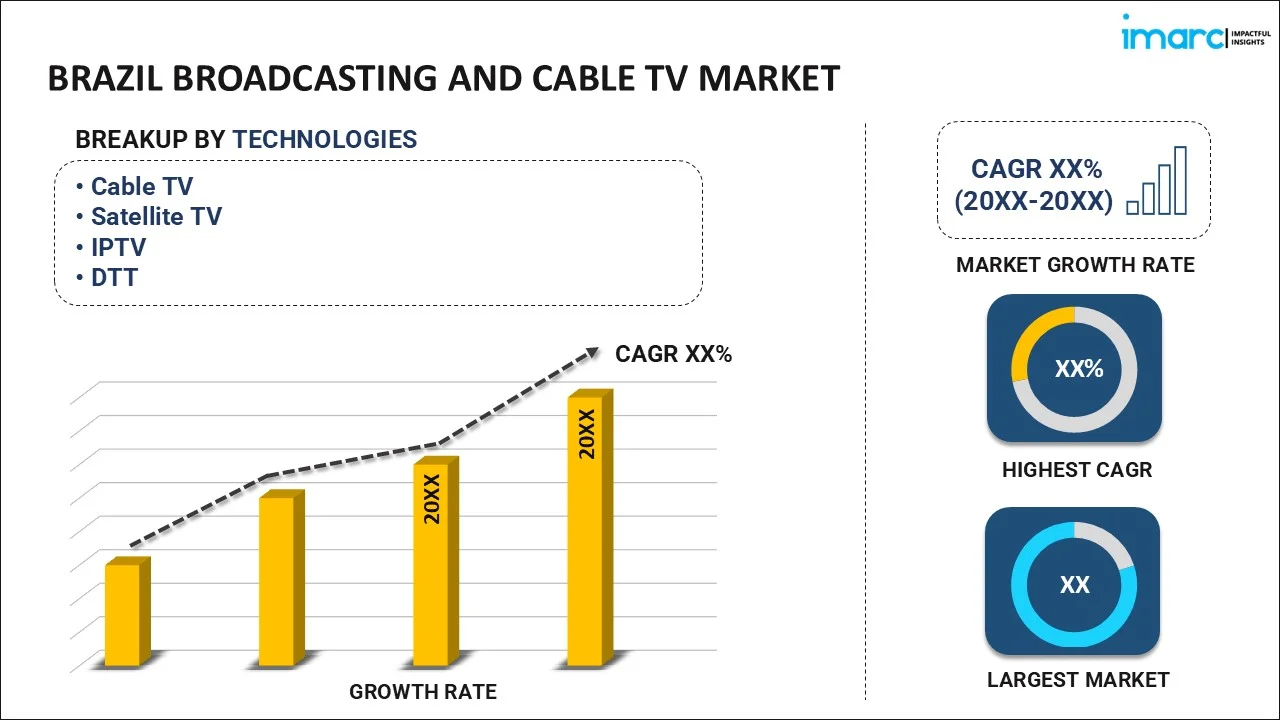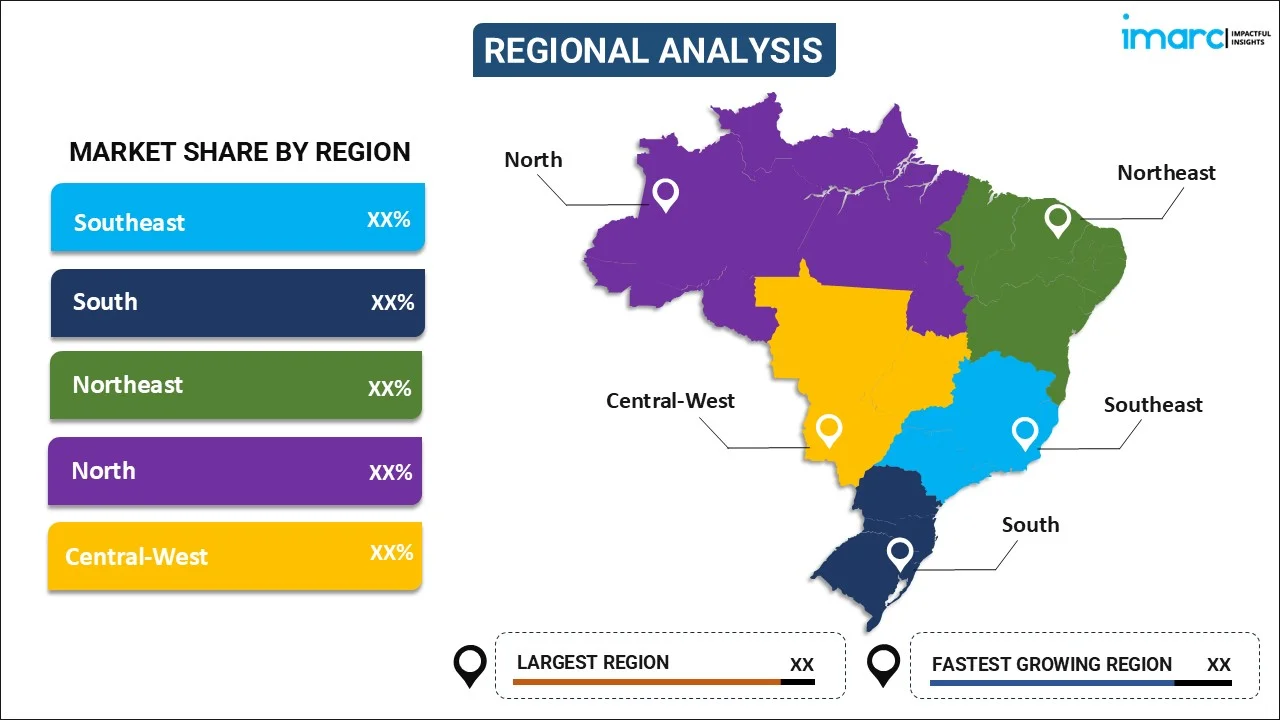
Brazil Broadcasting and Cable TV Market Size, Share, Trends and Forecast by Technology, Revenue Channel, and Region, 2026-2034
Brazil Broadcasting and Cable TV Market Overview:
The Brazil broadcasting and cable TV market size reached USD 10,517.9 Million in 2025. Looking forward, IMARC Group expects the market to reach USD 16,688.3 Million by 2034, exhibiting a growth rate (CAGR) of 5.26% during 2026-2034. The market is driven by the growing demand for digital content, increasing investments in high-definition and 4K broadcasting, expanding internet penetration for streaming services, rising adoption of on-demand platforms, and government initiatives supporting digital transformation in media distribution.
|
Report Attribute
|
Key Statistics
|
|---|---|
|
Base Year
|
2025 |
|
Forecast Years
|
2026-2034
|
|
Historical Years
|
2020-2025
|
| Market Size in 2025 | USD 10,517.9 Million |
| Market Forecast in 2034 | USD 16,688.3 Million |
| Market Growth Rate (2026-2034) | 5.26% |
Brazil Broadcasting and Cable TV Market Trends:
Shift Toward Digital and High-Definition Broadcasting
In Brazil, the transition to digital and high-definition (HD) broadcasting is transforming the broadcasting and cable TV industry. With the country's analog-to-digital switchover complete, HD content is increasingly available, offering better picture and sound quality and improving viewer experiences. Broadcasters and consumers alike are buying HD-capable equipment, driving demand for high-end digital services. Also, the government's initiative for digitalization in broadcasting is encouraging businesses to embrace HD and 4K technologies, which is leading the way for more sophisticated content formats. This is also creating new revenue streams through advertising and subscription services as viewers increasingly prefer high-definition content. As the Brazilian market shifts to better quality television broadcasts, providers of content within Brazil are looking to take advantage of this requirement by increasing their HD content provisions and improving transmission infrastructure.
Growing Popularity of Streaming and On-Demand Content
Growing usage of streaming websites is dramatically transforming the model of traditional cable television in Brazil. With enhanced availability of internet services and falling costs of smart devices, audiences are moving away from traditional cable television to streaming services and on-demand viewing, seeking flexibility in timing. Sites like Netflix, Amazon Prime, and domestic streaming platforms are benefiting from this trend through localized content offering, which strongly appeals to Brazilians. This shift to streaming is also making it possible for new broadcasters and content creators to come into the market, serving niche programming to specific demographic niches. As competition between streaming platforms increases, emphasis on exclusive and original programming increases, over time changing consumer behavior and reorienting business models from classic cable subscriptions to online subscriptions and advertising-supported ones.
Expanding Investment in Localized and Regional Content
Investment in localized content is another notable trend shaping Brazil’s broadcasting and cable TV market. Local broadcasters and streaming platforms recognize the importance of creating content that reflects Brazilian culture, languages, and regional preferences, appealing directly to local audiences. This emphasis on regional content helps providers stand out in a market crowded with international media and fosters loyalty among viewers who prefer culturally relevant programming. Additionally, government regulations encourage local content production, which further drives investment in Brazilian movies, series, and regional programming. As streaming services continue to expand, the demand for localized productions grows, fueling collaboration between production studios, broadcasters, and digital platforms. This focus on regional content strengthens brand affinity and expands market reach, positioning providers to better serve Brazil’s diverse population with content that resonates on a cultural and social level.
Brazil Broadcasting and Cable TV Market Segmentation:
IMARC Group provides an analysis of the key trends in each segment of the market, along with forecasts at the region level for 2026-2034. Our report has categorized the market based on technology and revenue channel.
Technology Insights:

- Cable TV
- Satellite TV
- IPTV
- DTT
The report has provided a detailed breakup and analysis of the market based on the technology. This includes cable TV, satellite TV, IPTV, and DTT.
Revenue Channel Insights:
- Advertising
- Subscription
A detailed breakup and analysis of the market based on the revenue channel have also been provided in the report. This includes advertising, and subscription.
Regional Insights:

- Southeast
- South
- Northeast
- North
- Central-West
The report has also provided a comprehensive analysis of all the major regional markets, which include Southeast, South, Northeast, North, and Central-West
Competitive Landscape:
The market research report has also provided a comprehensive analysis of the competitive landscape. Competitive analysis such as market structure, key player positioning, top winning strategies, competitive dashboard, and company evaluation quadrant has been covered in the report. Also, detailed profiles of all major companies have been provided.
Brazil Broadcasting and Cable TV Market News:
- In October 2024, Brazil’s leading broadcaster, Globo, plans to roll out the TV 3.0 platform nationwide in 2025. This next-generation platform aims to redefine the viewing experience.
- In October 2023, Brazil’s National Public Communication Network (RNCP), led by Empresa Brasil de Comunicação (EBC), is set for its largest expansion to date. During an event at the Planalto presidential palace, EBC signed cooperation agreements with the National Association of Heads of Federal Higher Education Institutions (Andifes) and 31 federal universities to launch 72 new radio and TV stations.
Brazil Broadcasting and Cable TV Market Report Coverage:
| Report Features | Details |
|---|---|
| Base Year of the Analysis | 2025 |
| Historical Period | 2020-2025 |
| Forecast Period | 2026-2034 |
| Units | Million USD |
| Scope of the Report |
Exploration of Historical Trends and Market Outlook, Industry Catalysts and Challenges, Segment-Wise Historical and Future Market Assessment:
|
| Technologies Covered | Cable TV, Satellite TV, IPTV, DTT |
| Revenue Channels Covered | Advertising, Subscription |
| Regions Covered | Southeast, South, Northeast, North, Central-West |
| Customization Scope | 10% Free Customization |
| Post-Sale Analyst Support | 10-12 Weeks |
| Delivery Format | PDF and Excel through Email (We can also provide the editable version of the report in PPT/Word format on special request) |
Key Questions Answered in This Report:
- How has the Brazil broadcasting and cable TV market performed so far and how will it perform in the coming years?
- What is the breakup of the Brazil broadcasting and cable TV market on the basis of technology?
- What is the breakup of the Brazil broadcasting and cable TV market on the basis of revenue channel?
- What is the breakup of the Brazil broadcasting and cable TV market on the basis of region?
- What are the various stages in the value chain of the Brazil broadcasting and cable TV market?
- What are the key driving factors and challenges in the Brazil broadcasting and cable TV market?
- What is the structure of the Brazil broadcasting and cable TV market and who are the key players?
- What is the degree of competition in the Brazil broadcasting and cable TV market?
Key Benefits for Stakeholders:
- IMARC’s industry report offers a comprehensive quantitative analysis of various market segments, historical and current market trends, market forecasts, and dynamics of the Brazil broadcasting and cable TV market from 2020-2034.
- The research report provides the latest information on the market drivers, challenges, and opportunities in the Brazil broadcasting and cable TV market.
- Porter's five forces analysis assist stakeholders in assessing the impact of new entrants, competitive rivalry, supplier power, buyer power, and the threat of substitution. It helps stakeholders to analyze the level of competition within the Brazil broadcasting and cable TV industry and its attractiveness.
- Competitive landscape allows stakeholders to understand their competitive environment and provides an insight into the current positions of key players in the market.
Need more help?
- Speak to our experienced analysts for insights on the current market scenarios.
- Include additional segments and countries to customize the report as per your requirement.
- Gain an unparalleled competitive advantage in your domain by understanding how to utilize the report and positively impacting your operations and revenue.
- For further assistance, please connect with our analysts.
 Request Customization
Request Customization
 Speak to an Analyst
Speak to an Analyst
 Request Brochure
Request Brochure
 Inquire Before Buying
Inquire Before Buying




.webp)




.webp)












